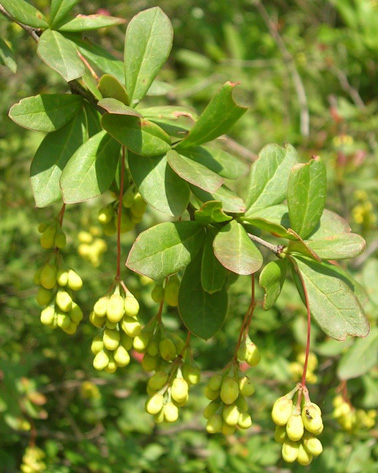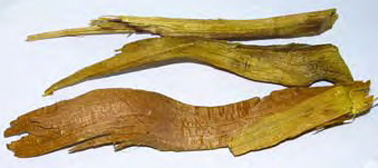|
Botanical Name:
Berberis aristata
Daruhalad consists of dried stem of Berberis aristata DC.,
Family
Berberidaceae
Common Name(s) in English & Indian Languages
Sanskrit: Katamkateri, Darvi
Bengali: Daruharidra
English: Indian Berberry
Guajarati: Daruharidra, Daruhuladur
Hindi: Daruhaldi, Darhald
Kannada: Maradarishana, Maradarishina, Daruhaladi
Malayalam: Maramannal, Maramanjal
Marathi: Daruhalad
Oriya: Daruharidra, Daruhalidi
Punjabi: Sumalu
Tamil: Gangeti, Varatiu manjal
Telugu: Manupasupu
Urdu: Darhald
Botanical description:
An erect, deciduous, heavily branched thorny shrub, up to 2
metres high. The thorny branches are angular, deeply
grooved, initially brownish yellow, later becoming
grey-white. The thorns are 1–2 cm long and protrude
horizontally. The leaves are compound, obovate to elliptoid
2–4 cm long, and bear leaflets with dentate margins and
spine. The flowers are 5–7 cm long in yellow, dense, hanging
clusters. Sepals are yellow and petals are orange at the
base. Ovary is superior with a flat stigma. The edible fruit
is a bright, scarlet, oblong-cylindrical berry, 10–13 mm
long and 6 mm thick,
containing 2 seeds. The exocarp is membranous-coriaceous.
Parts used:
Root, Bark
Major chemical constituents:
Alkaloids
Therapeutic uses:
• Itching (Kandu)
• Obesity (Medoroga)
• Diseases of mouth (Mukharoga)
• Ulcer (Vrana)
• Diarrhoea due to indigestion (Amatisara)
• Disease due to Kapha dosa (Kapharoga)
• Disease of ear (Karnaroga)
• Disease of eyes (Netraroga)
• Excessive flow of urine (Meha) |
|


|
|
|



